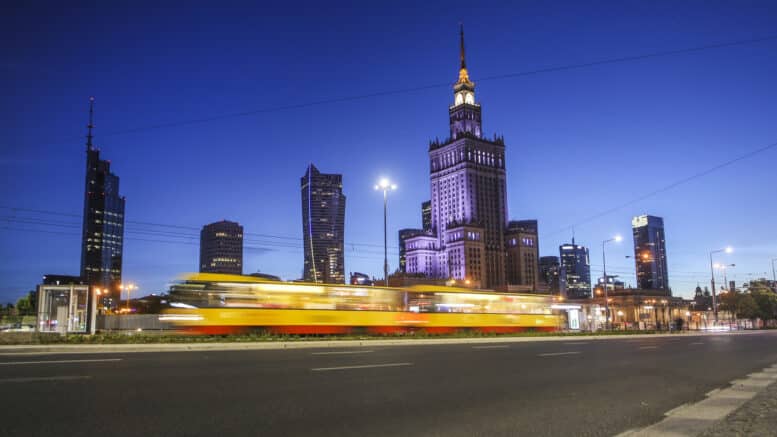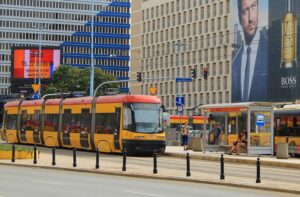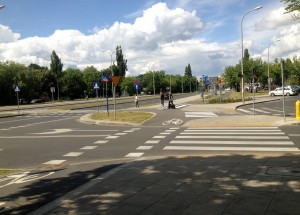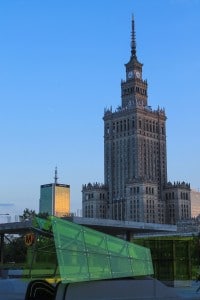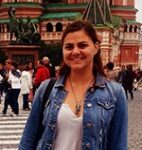Poland offers a broad network of public transportation with Warsaw serving as the central hub. Traveling to and around Warsaw is simple whether you arrive by plane or train. Warsaw’s international airport (Frederic Chopin) has a few direct bus lines to the city center, taking around half an hour to get from Chopin to Centralny (the main train station, also serves as the crossroads for other transport). If you arrive by plane to Modlin Airport to the north of the city, there is a easy transfer bus from the airport to city center (and beyond to Łódź). Many international trains arrive directly to Centralny, depositing passengers in the heart of Warsaw. The transport authority in Warsaw is ZTM, and they deal with trams, buses, and the city. Extensive tram and bus lines reach the outskirts of the city, including Praga (a district across the river). Regional train lines allow easy travel from Warsaw to the northeastern lake district of Masurian, north to Tricity (Gdansk, Gdynia, and Sopot), or south to Krakow, to name just a few places of interest. There are maps located inside whichever transport you’re using, and signs are, for the most part, posted in English and Polish.
Trams
Trams are the oldest transport in Warsaw, going back to the 1860s with horse-drawn trams. The city eventually implemented the electric-powered trams in the early 1900’s, and trams were the main transport until the Nazi invasion in 1930. The transportation infrastructure was completely destroyed following the Warsaw Uprising, but trams lines were quickly rebuilt under Soviet rule. The city has been modernizing its trams since the early 2000s, and expanding lines concurrently. The vintage ‘T’ tram runs in July and August and takes a wide turn around the city, seeing many of the main tourist sights.
Buses
After serving solely soldiers during the Polish-Soviet War, buses began operating again in 1945 after World War II. They’ve had a tumultuous relationship with the city due to driver shortages, policy changes, and funding. They weren’t popular until the ’90s when the buses and lines became more efficient. Many nations have gifted Poland with buses throughout the century, but now Solaris, a private Polish company based in Poznan, produces the largest share of Warsaw buses. Currently, there are around 170 routes throughout the city and night lines (characterized by ‘N’) service the night owls after the metro closes. There are two bus lines catering to tourists: the double-decker, weekend-only ‘100’ and the ‘180’ which follows the “Royal Route.”
Metro
The M1 line was finally operational in 1995, after going through multiple attempts to complete and open it that spanned six decades. Warsawians are fond of griping about the choice made during the ’50s: Stalin offered to gift Warsaw with a metro line, but Polish Communist leader Bierut chose to have the Palac Kultury i Nauki instead. Collegium Civitas is housed in the Palac, a massive structure reminiscent of Moscow’s “Seven Sisters.” This is actually a shame if you’ve seen the beauty of Russian metros. Regardless, the M1 Line now runs north-south, Mlociny to Kabaty, 21 stops in total. 2015 marks the opening of the second metro line, adding six more stops to the system. The second line runs east-west and stretches across the Vistula River, with a stop specially for the National Stadium (Stadion Narodowy). Planning is underway for extending the M2 by twenty more stops, and an M3 line consisting of 8 stations.
Bikes
Bike lanes have slowly begun becoming a part of the city’s transportation plans. While biking was always a part of movement in the city, now you can find specially marked bike lanes and corresponding traffic signals. You can also find city bikes for rent throughout the town with hourly or daily rates.
Tickets
There are a few options for buying transportation tickets in Warsaw, and really depend on the length of your stay. Options for single-use tickets include 20-minutes, single transfers, one-day, weekend, or group weekend tickets. Buying a single bilet for Zone/Strefa 1 will typically suffice the average tourist’s needs. If you wander outside Zone 1 (central Warsaw including a portion across the river), then you’ll need to buy a ticket which includes that zone. If you’re staying longer than a month, consider buying a “personal Warsaw City” card which is valid for buses, trams, and metros. They have student deals, and allow for 30- or 90-day choices with top-ups available (check www.ztm.waw.pl for current ticket tariffs, deals, maps, and other info). Tickets may be bought at news kiosks or the ticket machines around the station, and sometimes from the bus/tram driver directly (but don’t bank on it).
Caution: not having a ticket can result in a fine of upwards 260 zloty, around $65. Being honest and paying for your ticket will help the city provide better public transit!
Enjoy your stay in Warsaw!
Helpful phrases/ words
north: północ (poo-nots)
south: południe (po-wud-niyeh)
east: wschód (visk-hood)
west: zachód (za-hood)
station: stacja (stas-iya) or dworzec (dvor-zhits)
train: pociąg (poach-yog)
tram: tramwaj (tram-vai)
(metro and bus are the same as their English counterparts)
Mlociny/ Zoliborz to the north of Centrum
Kabaty/ Mokotow to the south of Centrum
Ochota to the west of Centrum
Praga to the east of Centrum


